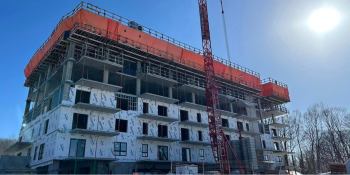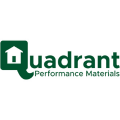Q&A Forums
vapor retarder Post New Topic | Post Reply
| Author | Comments |
|---|---|
|
Posted: Feb 25, 2006 09:41 AM
|
vapor retarder
when to where to should we? it would be interesting to hear the opinions out there,,,,seems to be a mountain of information/misinformation out there.... |
|
Posted: Mar 07, 2006 08:37 PM
|
I thought that if the foam was 2.5" to 3" thick you didn't need a plastic vapor barrier. |
|
Posted: Mar 16, 2006 06:19 AM
|
lets see if we can get this IMPORTANT dialoge started... what is the vapor permience of OPEN CELL foam? of CLOSED CELL foam? what permience rating constitutes a vapor barrier/retarder? where does a vapor barrier get applied? |
|
Posted: Mar 18, 2006 08:11 AM
|
help!!! we gotta have this dialoge...!!! PLEASE POST! we need info and opinions so we can all be better at what we do!! A vapor retarder is a material that restricts or reduces the rate and volume of water vapor diffusion through the ceilings, walls, and floors of a building. Building materials at a given thickness are tested and given a permeance rating.(ASTM E96) This rating measures the amount of water vapor that can pass through it. The thicker a building material is the greater its ability is to restrict vapor diffusion. Building materials with a permeance rating less than 1.0 are considered a vapor retarder. LETS POST THE E96 RATEINGS FOR THE FOAM WE APPLY lets see what the numbers are. if we are forced to look,,we will be forced to know...to make informed decisions... example...sprayed a 3/4" closed cell building envelope around the perimeter of a home...local fiberglass company came behind and net an blow a BIBS system fiberglass to fill cavity.... then, why i dont know...the fiberglass VP said "no vapor barrier needed" and away they sheet-rocked,,then they textured mudded and painted all the while running the homes furnace as well as multiple non-vented combustion devices(read: LP heaters)...and the temp fell to -5 degrees for about 3 days....well the moisture vapor passed thru the wall to condensate(frosted) on the next solid surface(face of foam in this case) and then it melted when it warmed...and then it RAN OUT OF THE WALL causing the home owner to FREAKOUT (and well he should!) well,,without the added moisture of the textureing and painting and all,,, the wall cavity was exposed to about 200 grains of condensation per square foot per day due to the extreme temp difference...with the added moisture,,damn who knows...but it must be an astronomical number if you consider it.. so there is a real world example of a decision made without consideration to the science of the application... our local code mandates a vapor barrier,, the shredded newspaper folks clearly state no vapor barrier for their product (they want the moisture they introduce into the wall cavity with the installation procedure to dry..to hell with the future of the structure) the local code officials are unaware that they are not putting up a vapor barrier..they inspect pre-insulation,,and then pre-occupancy..so they dont know this is going on.... here in the cornfield,,these walls will be wet at some time...all the time,,,for the life of the home...not a good formula! please post.. lets keep this dialoge going... "inquireing minds need to know" |
|
Ryan Rhoads
Posted: Mar 20, 2006 02:07 PM
|
According to the IBC or international building code, I need to double check though, it states that there should be a vapor barrier on the warm side of the building. Meaning in Colorado it's on the inside and in Arizona it would be on the outside. The reason for this is that warm moist air tries to migrate to the colder area. It is nature way of balancing things. When warm moist air come into contact with a surface that is colder than the dew point you get condensation. Utilizing closed cell foam to a thickness that the permiablity is less than 1.0 and at suffiecent depth to witch the dewpoint can not be achieved will eliminate condensation. Closed cell foam at depth's, I believe it is 2" for 1.7 pound foam (check with your supplier though) does not need a vapor barrier on either side. If someone however does ask you to spray on the cold side of the building and then they install any loose fill or batt type insulation to fill the cavity and then installs the vapor barrier on the warm side of the building you may see serious effects. What happens here is warm moist air, vapor drive, does find those overlaping joints and cut outs for plumbing/electrical and migrates through them. When this happens do to convection currents in the non ridged insulation this warm moist air moves up inside the wall cavity and will most times find a cold spot thus condense, sometimes at the double top plates of a wall section where cold air can seep between the two plates as well as the R-value of wood is not very good so you get thermalbridging. Now you have wet insulation that promotes mold growth and wood rot. Many people will protest that mold will not grow within cellulose and fiberglass insulations. Well contrary to popular belief when that warm moist air is finding it's way through every nook and cranny in the vapor barrier it can also carry mold spores and organic matter. All of this including the paper backing of the sheet rock and the wood studs can give ample food sources for the mold. This moisture other than reducing the effective R-value helps to hold the moisture. Personally I believe that it is better not to use a vapor barrier but code is code. Without the use of the vapor barrier you at least stand a chance to of the moisture returning to vapor form and being able to escape back through the sheetrock. Ideally the best choice is to use all closed cell foam or all open cell foam and install a vapor barrier on the warm side of the building. Even though open cell foam does not achieve a permiability rating of less than on it does not allow convection currents and more importantly moisture to migrate through it very easily. This keeps the moisture close to the point where it has entered the insulation and thus allowing it to evaporate back out through the same path later. The other great about using foam is that it does not allow the vapor to reach the dew point unless by some miracle your home spontanously turns into a freezer. Well these are just my thoughts. I am not an expert on the subject but I hope it helps and don't feel bad to contradict me due to that is how we can all learn more about this industry |
|
Posted: Mar 22, 2006 06:45 PM
|
the foam i shoot... permeance: ASTM E96 closed cell: .95@ 2" .88@3" .56@4" open cell: 16.42@3" |
|
Posted: Mar 22, 2006 08:44 PM
|
My 2 cents. I am not a big fan of vapor retarders added to wall cavities. It goes deeper then perm ratings alone. Perm ratings are kind of like R-values at times they mean nothing. We need to realize that whether in the north or south the vapor retarder is on the wrong side half the year. no good up north in the summer no good down south in the winter. We have a tendancy to emphasize to heavily on vapor diffusion. A lot of the time this condensation problem we encounter is air laden moisture coming from the outside.Dont get me wrong vapor diffusion does at times pose problems, however most times its because the relative humidity on the inside of the structure is way to high, and needs to be remedied by means of ventilation. Drywall that is painted with latex paint should be vapor retarder enough for a properly humidified structure. As mentioned frost on .75" of closed cell that is not fault of insulation but severely over humidified home. Vapor retarders are not going to remedy such problems whether we use them or not. Build tight and mechanically ventilate and we will never have a problem guarenteed. Lets keep it simple and use common sense approaches.If we are going to build tight we need to control indoor humidity. As to not run into problems.The science of humidity whether relative or absolute is usually not as important as common sense. Foam on all |
|
Posted: Mar 23, 2006 09:24 PM
|
sprayfoam1 i modeled the wall with and without a vaporbarrier.. the condensation is almost 100times greater without than with..this was without increasing the indoor humidity above 30%... i then ran it at 75% indoor humidity and it still was scant with and 100 times greater without... damn computers.. hee hee |
|
Posted: Mar 28, 2006 09:13 PM
|
What is a vapor retarder? A vapor retarder is a material that restricts or reduces the rate and volume of water vapor diffusion through the ceilings, walls, and floors of a building. Building materials at a given thickness are tested and given a permeance rating. This rating measures the amount of water vapor that can pass through it. The thicker a building material is the greater its ability is to restrict vapor diffusion. Building materials with a permeance rating less than 1 are considered a vapor retarder. What makes a vapor retarder different from an air barrier? The vapor retarder should not be confused with an air barrier. A vapor retarder is designed to minimize the amount of water vapor passing through it. In comparison an air barrier is designed to stop air movement that could bring water vapor into a building assembly. Some air barriers are designed to allow water vapor to pass through to allow its evaporation and to allow the drying of the building assembly. Why use a Vapor Retarder? |
|
Posted: Mar 29, 2006 09:05 PM
|
Why use a Vapor Retarder? The main reason for retarding the transmission of water vapor through the building envelope is to prevent water vapor from condensing back into liquid form within the building structure cavities. Where is a Vapor Retarder installed? The local climate and the heating/cooling needs of a building determine where the vapor retarder is installed. Where the vapor retarder gets installed primarily depends on the local climate and the heating and cooling needs of a building. For buildings in a heating climate, the vapor retarder is placed on the inside or the warm side of the building envelope. The reason for this is that the cold air outside will hold less moisture then the warm air inside a building. It is the warm, moist air inside a building that can get into the building envelope and condense when it contacts the colder surface, usually on the backside of the exterior wall sheathing. This is called “the first condensing surface.” With the vapor retarder on the inside and a vapor permeable air retarder on the outside, any water vapor that does condense inside will be able to evaporate and dry through the permeable air retarder to the outside. In a cooling climate, the vapor retarder should be placed on the outside of the building envelope. In a cooling climate, the outside air is warmer, and has the potential of containing more water vapor than the inside air. Placing the vapor retarder on the outside will reduce water vapor movement from the outside from getting into the building envelope. Any vapor that does get into the walls or roof assembly can evaporate to the inside and therefore dry out before the moisture can lead to mold, mildew and rot problems. |
|
Posted: Mar 30, 2006 10:00 PM
|
Foamdude- I do not spray open cell so Im not familiar with the need for a V.R. with open cell. I am an old school rigid guy who knows that with 2" of closed in a wall cavity and a foam perm of 0.7 an additional V.R. in not needed. That is why I am totally for closed cell in exterior wall cavities. The vapor retarter is never on the wrong side. |
|
Posted: Apr 01, 2006 08:43 AM
|
does anyone have an RX for "Energy Design Update" if so,,please look at july 2005 for some interesting reading on a foam system failure.. a system failure that is still being utilized here in my area by a multitude of applicators and a variety of products... ....living on the edge... |
|
Stacy Allen
Posted: Aug 29, 2006 03:37 PM
|
This whole vapor barrier issue has me very confused as to what to do. The situation: I live in San Diego County (inland) Avg. relative humidity is approx 50-60%(Although mornings can be up to 70%) We never get to freezing(32DegF) and rarely see temps in exceess of 100Deg F. When I built my home a year ago, I included a room that I intended to use for wine storage. It is approx. 7' square and 10'High ceiling. It is framed with 2 x 6 and insulated w/ fiberglass batts. I never thought to install avapor barrier. All walls are "inside" walls with one wall having about 2 lineal feet that is an "outside" wall. I need to install a refrigeration unit for the space and EVERYONE is telling me that the conventional wisdom, (which doesn't seem to have any regards for where you live) is that a vapor barrier is a MUST. Based on how the "room" is situstaed and constructed, getting to the warm side of the wall will be a nightmare AND, I don't see how it can realistically be done while completely sealing. I got to researching Polyu and it seems like maybe a better idea. My other issue is that I may have to ADD humidity to my storage room. One thought that I had was to frame a 2 x 2 wall inside my room and spray polyurethane into the cells and then either dry wall or plaster over. Can anyone offer a well reasoned opinion about my situation? |
|
John Shockney
Posted: Aug 29, 2006 07:14 PM
|
2foamornot2foam, Your 2x2 thought is not the best answer, better is to spray 2inches of closed cell directly on the inside walls and ceiling, then apply a good paint or there is a premixed stuco type materal that can be applied if you want a better finish than the foam. Also you should not need to add humidity to the room if the refergeration equpment is properly designed so that the evaperator temp doesn't drop below the saturation temp (dewpoint) for your desired humidity/tempiture seting. This link has good info on condensation problems, solutions, and the sceince involved. Hope this helps thanks Airpro |
|
Stacy Allen
Posted: Aug 30, 2006 03:36 PM
|
Thanks Airpro....That is a very intriguing idea. Can you give me some guidance on the "premixed stucco material"? A plastered look is actually very appealing. This stucco that you speak of can be applied directly over the closed cell foam? Do I need any sort of lath? Or if I choose paint, is there any type of paint that is better than others for this? |
|
John Shockney
Posted: Aug 31, 2006 11:49 PM
|
Any good qualty latex paint will work don't forget the primer. The stucco I was talking about is applied to the foam or other base materal directly over a fiberglass or nylon mesh. <<<<<this link is one suppler Hope this helps Thanks Airpro |
|
Tony Huber
Posted: Sep 07, 2006 02:06 PM
|
We are just starting to use these products in our custom homes. Our sales rep. explained that the roof membrane is the vapor barrier. We will be using open cell only in a closed roof system. We use a solid vinyl soffit with no ventilation in the attic at all-closed- and the foam is sprayed over the soffit and every surface up to the drywall of the ceiling. We are told there is no need for any vapor barrier or insulation at ceiling level. Here in FLA it is really amazing,we visited the owner of the insulation co house and were in his attic which would normally be around 140F and it was 78F. The attic was kept cool by normal leakage from the a/c ducts in the attic. The pricing is about 2.5 time the cost of R30 batts |





























